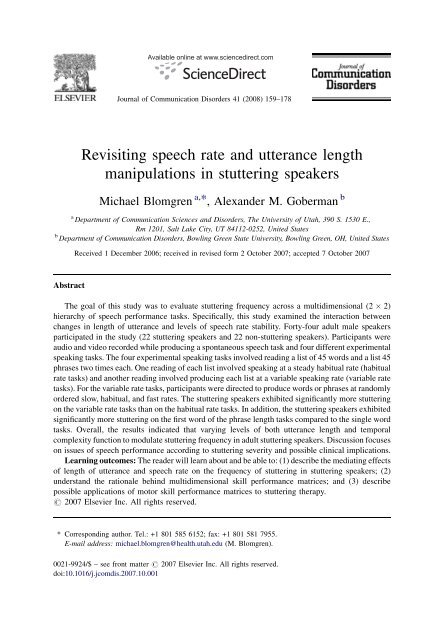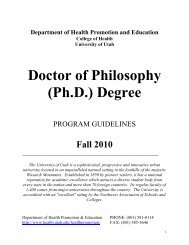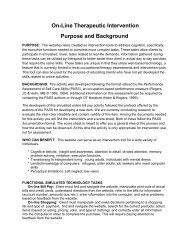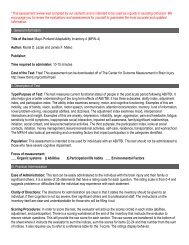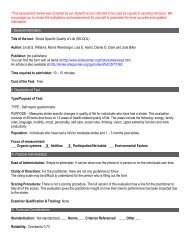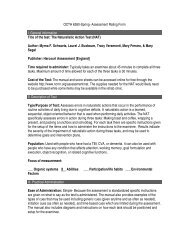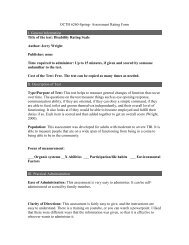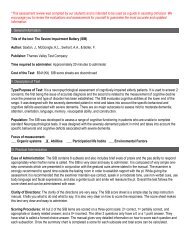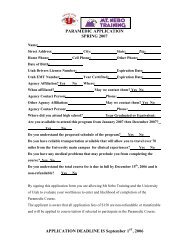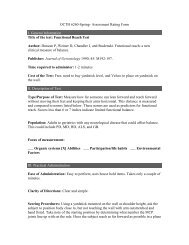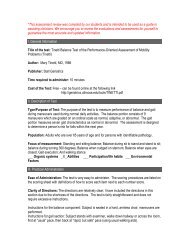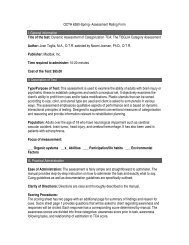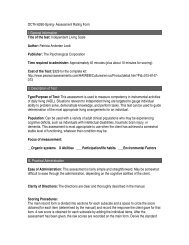Revisiting speech rate and utterance length ... - ResearchGate
Revisiting speech rate and utterance length ... - ResearchGate
Revisiting speech rate and utterance length ... - ResearchGate
You also want an ePaper? Increase the reach of your titles
YUMPU automatically turns print PDFs into web optimized ePapers that Google loves.
Available online at www.sciencedirect.comJournal of Communication Disorders 41 (2008) 159–178<strong>Revisiting</strong> <strong>speech</strong> <strong>rate</strong> <strong>and</strong> <strong>utterance</strong> <strong>length</strong>manipulations in stuttering speakersMichael Blomgren a, *, Alex<strong>and</strong>er M. Goberman ba Department of Communication Sciences <strong>and</strong> Disorders, The University of Utah, 390 S. 1530 E.,Rm 1201, Salt Lake City, UT 84112-0252, United Statesb Department of Communication Disorders, Bowling Green State University, Bowling Green, OH, United StatesReceived 1 December 2006; received in revised form 2 October 2007; accepted 7 October 2007AbstractThe goal of this study was to evaluate stuttering frequency across a multidimensional (2 2)hierarchy of <strong>speech</strong> performance tasks. Specifically, this study examined the interaction betweenchanges in <strong>length</strong> of <strong>utterance</strong> <strong>and</strong> levels of <strong>speech</strong> <strong>rate</strong> stability. Forty-four adult male speakersparticipated in the study (22 stuttering speakers <strong>and</strong> 22 non-stuttering speakers). Participants wereaudio <strong>and</strong> video recorded while producing a spontaneous <strong>speech</strong> task <strong>and</strong> four different experimentalspeaking tasks. The four experimental speaking tasks involved reading a list of 45 words <strong>and</strong> a list 45phrases two times each. One reading of each list involved speaking at a steady habitual <strong>rate</strong> (habitual<strong>rate</strong> tasks) <strong>and</strong> another reading involved producing each list at a variable speaking <strong>rate</strong> (variable <strong>rate</strong>tasks). For the variable <strong>rate</strong> tasks, participants were directed to produce words or phrases at r<strong>and</strong>omlyordered slow, habitual, <strong>and</strong> fast <strong>rate</strong>s. The stuttering speakers exhibited significantly more stutteringon the variable <strong>rate</strong> tasks than on the habitual <strong>rate</strong> tasks. In addition, the stuttering speakers exhibitedsignificantly more stuttering on the first word of the phrase <strong>length</strong> tasks compared to the single wordtasks. Overall, the results indicated that varying levels of both <strong>utterance</strong> <strong>length</strong> <strong>and</strong> temporalcomplexity function to modulate stuttering frequency in adult stuttering speakers. Discussion focuseson issues of <strong>speech</strong> performance according to stuttering severity <strong>and</strong> possible clinical implications.Learning outcomes: The reader will learn about <strong>and</strong> be able to: (1) describe the mediating effectsof <strong>length</strong> of <strong>utterance</strong> <strong>and</strong> <strong>speech</strong> <strong>rate</strong> on the frequency of stuttering in stuttering speakers; (2)underst<strong>and</strong> the rationale behind multidimensional skill performance matrices; <strong>and</strong> (3) describepossible applications of motor skill performance matrices to stuttering therapy.# 2007 Elsevier Inc. All rights reserved.* Corresponding author. Tel.: +1 801 585 6152; fax: +1 801 581 7955.E-mail address: michael.blomgren@health.utah.edu (M. Blomgren).0021-9924/$ – see front matter # 2007 Elsevier Inc. All rights reserved.doi:10.1016/j.jcomdis.2007.10.001
160M. Blomgren, A.M. Goberman / Journal of Communication Disorders 41 (2008) 159–1781. IntroductionThe history of stuttering research is replete with examinations of the effects of variousmotor <strong>and</strong> linguistic complexity manipulations on the <strong>speech</strong> of people who stutter. Two ofthe most widely examined factors thought to influence frequency of stuttering are <strong>speech</strong><strong>rate</strong> (e.g., Andrews & Harris, 1964; Boberg & Kully, 1985; Goldiamond, 1965; Guttmann,1893; Helps & Dalton, 1979; Howie & Woods, 1982; Ingham, 1975; Johnson & Rosen,1937; Smith & Kleinow, 2000; Starkweather, 1987; Vanryckeghem, Glessing, Brutten, &McAlindon, 1999) <strong>and</strong> <strong>utterance</strong> <strong>length</strong> (e.g., Brown & Moren, 1942; Brundage & Ratner,1989; Kleinow & Smith, 2000; Logan & Conture, 1995; Riley & Ingham, 2000; Silverman,1972; Soderberg, 1966; Tornick & Bloodstein, 1976; Wells, 1979; Wingate, 1967). Takentogether, the findings of these studies strongly support the notion that increased motor <strong>and</strong>/or linguistic speaking task complexity result in decreased <strong>speech</strong> fluency for stutteringspeakers. However, the interaction between various types of different speaking taskcomplexities are not well understood (Howell, Au-Yeung, & Pilgrim, 1999; Max &Gracco, 2005). The purpose of the present study was to examine the interaction (<strong>and</strong>relative strengths) of a motor variable (<strong>speech</strong> <strong>rate</strong> stability) <strong>and</strong> a linguistic variable(<strong>length</strong> of <strong>utterance</strong>) on stuttering frequency.Considering the temporal aspects of <strong>speech</strong> production, there is general agreement thatif a stuttering speaker reduces his/her <strong>speech</strong> <strong>rate</strong> they will also reduce their stutteringfrequency (e.g., Andrews & Harris, 1964; Boberg, 1976; Boberg & Kully, 1985; Johnson &Rosen, 1937; Onslow, Costa, Andrews, Harrison, & Packman, 1996; Runyan & Runyan,1986; Webster, 1980). It has also traditionally been reported that increased <strong>speech</strong> <strong>rate</strong>usually results in increased stuttering (e.g., Bloodstein, 1944; Howell et al., 1999; Johnson& Rosen, 1937). For example, Kalinowski, Armson, Rol<strong>and</strong>-Miezkowski, Stuart, <strong>and</strong>Gracco (1993) reported that seven of their nine participants displayed increased stutteringduring speaking tasks involving a fast speaking <strong>rate</strong> compared to habitual <strong>rate</strong> tasks.However, Kalinowski, Armson, <strong>and</strong> Stuart (1995) later found no difference in stutteringfrequency between habitual <strong>and</strong> fast speaking <strong>rate</strong>s, which led these researchers toconclude that increased <strong>speech</strong> <strong>rate</strong> does not determine stuttering frequency with the sameconsistency as does decreased <strong>speech</strong> <strong>rate</strong>. While it appears that the exact effect of changesin speaking <strong>rate</strong> on stuttering frequency may vary somewhat among stuttering speakers, itis generally accepted that changes in the temporal dynamics of <strong>speech</strong> do produce changesin stuttering frequency. These findings support suggestions that stuttering is, at least in part,a disorder of <strong>speech</strong> timing (Cooper & Allen, 1997; De Nil, Kroll, & Houle, 2001; Kent,1984; Van Riper, 1982).Extant research evaluating <strong>length</strong> of <strong>utterance</strong> has shown that stuttering is less likely tooccur on shorter <strong>utterance</strong>s compared to longer <strong>utterance</strong>s (e.g., Brown & Moren, 1942;Brundage & Ratner, 1989; Logan & Conture, 1995; Silverman, 1972; Soderberg, 1966;Wells, 1979; Wingate, 1967). For example, Tornick <strong>and</strong> Bloodstein (1976) found that lessstuttering occurred in the reading of short sentences (e.g., ‘‘She learned to swim.’’) whenthis sentence stood alone compared to when it was the initial part of a longer sentence (e.g.,‘‘She learned to swim in the clear water of the lake.’’). Logan <strong>and</strong> Conture (1995) have alsosupported the observation of less stuttering on short sentences in young children whostutter.
M. Blomgren, A.M. Goberman / Journal of Communication Disorders 41 (2008) 159–178 161Length of <strong>utterance</strong> may be considered a spatial variable in <strong>speech</strong> production as theamount of spatial planning (segmental as well as coarticulatory) required to produce aseries of phonetic targets increases from words to phrases to sentences. For example,production of a single CVC word such as ‘‘bat’’ requires advance spatial planning for threephonetic targets, while production of even a simple sentence such as ‘‘Susan picked up thebat’’ requires advance planning for approximately 16 phonetic targets (Perkell & Nelson,1982). Length of <strong>utterance</strong> may also be viewed as a linguistic variable, as longer <strong>utterance</strong>swould typically be more syntactically complex than shorter ones. However, the influence of<strong>length</strong> of <strong>utterance</strong> <strong>and</strong> syntactic complexity is not necessarily analogous. For instance,Ratner <strong>and</strong> Sih (1987) reported that fluency breakdown in both stuttering <strong>and</strong> nonstutteringchildren is more highly correlated with increases in syntactic complexity than<strong>length</strong> of <strong>utterance</strong>. Further, Kleinow <strong>and</strong> Smith (2000) reported that adult stutteringspeakers (during perceptually fluent <strong>speech</strong>) exhibited decreased <strong>speech</strong> motor stabilityduring production of more syntactically complex <strong>utterance</strong>s but did not exhibit decreasedstability during simply longer <strong>utterance</strong>s (controlled for syntactic complexity). While theeffects may at times be subtle, certain aspects of linguistic structure do appear to have clearmediating effects on stuttering frequency in both children <strong>and</strong> adults (Au-Yeung & Howell,1998; Brown, 1945; Wingate, 1988; Wolk, Blomgren, & Smith, 1998).As the realized motor sequelae of thought <strong>and</strong> language, <strong>speech</strong> is one of the mostcomplex movement sequences produced by humans. As such, it is practically impossible toexamine every single mediating variable. In order to examine complex movementsequences in non-<strong>speech</strong> motor routines, dynamic systems theories have been developed.The goal of dynamic systems theory is to use multidimensional models to underst<strong>and</strong> thepatterns that arise from coordinated movement (Kelso, 1988). To form a multidimensionalmodel, the identification of relevant pattern variables in the complex system is crucial(Thelen, Kelso, & Fogel, 1987). Thelen (1988) states: ‘‘The first step toward a dynamicalmodel of any developmental phenomenon is underst<strong>and</strong>ing the behavior over time. Herewe face the nontrivial (<strong>and</strong> maybe even monumental) task of choosing the appropriatecollective variable: how best to capture the compression of the degrees of freedom.’’ (p.365). Therefore, in order to create a workable dynamical model of behavior, degrees offreedom must first be reduced.To properly reduce the degrees of freedom in an examination of <strong>speech</strong> production,relevant variables must first be chosen, <strong>and</strong> one method of identifying relevant variables isthrough examination of physiological <strong>and</strong> linguistic constraints (Kelso, 1995). Twofundamental constraints for fluent <strong>speech</strong> production are <strong>speech</strong> <strong>rate</strong> <strong>and</strong> <strong>length</strong> of<strong>utterance</strong> (Howell et al., 1999; Kent & Read, 1992; Kleinow & Smith, 2000; Smith &Kleinow, 2000). Speech <strong>rate</strong> refers to the number of phonemes, syllables, or words per unitof time, while <strong>length</strong> of <strong>utterance</strong> refers to the number of phonemes, syllables, or wordsproduced in any particular <strong>utterance</strong>. Speech <strong>rate</strong> is temporally constrained because thereis a finite speed (both slow <strong>and</strong> fast) at which intelligible <strong>speech</strong> can reasonably beproduced, <strong>and</strong> <strong>length</strong> of <strong>utterance</strong> is constrained due to both respiratory dem<strong>and</strong>s (i.e.,breath groups) <strong>and</strong> to semantic/syntactic realities (e.g., the need for informationchunking).In summary, <strong>rate</strong> of <strong>speech</strong> <strong>and</strong> <strong>length</strong> of <strong>utterance</strong> may be thought of as the fundamentaltemporal/motor <strong>and</strong> spatial/linguistic variables in normal <strong>speech</strong> production, respectively.
162M. Blomgren, A.M. Goberman / Journal of Communication Disorders 41 (2008) 159–178As discussed, these same two variables also serve as modulating variables for frequency ofstuttering in stuttering speakers. However, the relative importance <strong>and</strong> possible interactionbetween these (<strong>and</strong> other) motor <strong>and</strong> linguistic variables is poorly understood in stutteringspeakers. One methodology to examine possible interactive effects of these variablescomes from the motor learning literature.Gentile (1987) <strong>and</strong> others (Hautala & Conn, 1993; Magill, 2004) have demonst<strong>rate</strong>dthat temporal <strong>and</strong> spatial variables are relevant to the description of non-<strong>speech</strong> motortasks (e.g., walking, hitting a golf ball, or buttoning a jacket) <strong>and</strong> they have modeledthese variables using multidimensional skill performance matrices. Within these skillmatrices, the various skill categories (or tasks) place varying dem<strong>and</strong>s on the performer.These skills are often classified on a continuum varying from relatively simple torelatively complex tasks. Tasks conducted at the simple end of the continuum arereferred to as closed motor skills <strong>and</strong> skills conducted at the complex end of thecontinuum are referred to as open motor skills (Gentile, 1972; Poulton, 1957). Closedmotor skills occur in a stable task environment <strong>and</strong> tend to be serially ordered,temporally stable, <strong>and</strong> spatially stable. Conversely, open motor skills occur in a nonstableenvironment, where the temporal or spatial aspects of the task change during theperformance of the task. This inter-trial variability is often the defining characteristic ofopen motor skills.As <strong>rate</strong> of <strong>speech</strong> <strong>and</strong> <strong>length</strong> of <strong>utterance</strong> have both been shown to affect stutteringfrequency, it was hypothesized that a 2 2 <strong>speech</strong> performance matrix would allow for atwo-dimensional examination of <strong>speech</strong> fluency along a continuum of <strong>speech</strong> taskcomplexity. If specific tasks vary in terms of stability of <strong>speech</strong> <strong>rate</strong> <strong>and</strong> <strong>length</strong> of <strong>utterance</strong>,this can allow for an examination of the relative contributions of temporal/motor <strong>and</strong>spatial/linguistic parameters on <strong>speech</strong> motor control. A 2 2 <strong>speech</strong> performance matrixis shown in Fig. 1. The goal of this particular arrangement of <strong>speech</strong> production tasks is tocreate a hierarchy of performance complexity ranging from a relatively closed task (a seriesof single words spoken at a stable <strong>rate</strong>) to a relatively open task (a series of phrases spokenat varying <strong>rate</strong>s of <strong>speech</strong>).Fig. 1. Illustration of 2 2 performance matrix applied to two <strong>speech</strong> variables: <strong>speech</strong> <strong>rate</strong> <strong>and</strong> <strong>length</strong> of<strong>utterance</strong>. The matrix displays a progression from a relatively closed task (series of single words produced at asteady habitual <strong>rate</strong>) to a more open task (series of phrases produced with variable <strong>rate</strong>s of <strong>speech</strong>). Note: 1: closedtask; 2 <strong>and</strong> 3: intermediate tasks; 4: open task.
M. Blomgren, A.M. Goberman / Journal of Communication Disorders 41 (2008) 159–178 163This is the second of a two-part series examining stuttering across 2 2performance matrices. An initial examination of 20 stuttering speakers found thatstuttering speakers produced increasing <strong>rate</strong>s of stuttering as a function of increasingtask complexity along both spatial <strong>and</strong> temporal dimensions. These initial results werepublished as part of a paper discussing issues related to programming complexityin stuttering therapy (Blomgren, 2001). However, a number of issues may have limitedthe ability to draw conclusions from the initially published results. First, the taskpresentation order was not r<strong>and</strong>omized across all participants, introducing a possibletask order effect. Second, non-stuttering control group data were not included.Third, the influence of stuttering severity on the results was not assessed. Therefore,the goals of the present study were to: (1) conduct a more controlled extension ofthe initial study on additional stuttering speakers; (2) add comparisons to a nonstutteringcontrol group; <strong>and</strong> (3) examine the effect of stuttering severity on taskperformance.In summary, the purpose of the present study was to assess the effects <strong>and</strong> theinteraction between two variables known to influence the frequency of stuttering instuttering speakers. Specifically, the present study examined the effect of both <strong>speech</strong><strong>rate</strong> stability <strong>and</strong> <strong>length</strong> of <strong>utterance</strong> on stuttering frequency. The current goal is to createa multidimensional model of stuttering behavior utilizing a 2 2 performance matrix,along with determining the effects of stuttering severity on the present assessmentmodel. The effect of stuttering severity may be especially important, as mild <strong>and</strong> severestutterers have been shown to be differentially affected by <strong>rate</strong> change (Vanryckeghemet al., 1999).2. Methods2.1. ParticipantsForty-four adult males participated in this study. Twenty-two of the participantsstuttered <strong>and</strong> 22 were normally fluent speakers. All participants were native speakers ofAmerican English <strong>and</strong> were between 18 <strong>and</strong> 62 years of age (stuttering speakers: M = 34.0,S.D. = 13.0; non-stuttering speakers: M = 31.0, S.D. = 11.0). All participants reported <strong>and</strong>exhibited normal or corrected-normal vision, normal hearing, <strong>and</strong> normal language, voice,<strong>and</strong> <strong>speech</strong> articulation.In an attempt to minimize possible treatment effects, only participants who had notreceived formal stuttering therapy within the past year were included in the study.Formal therapy was defined as that provided by a <strong>speech</strong>-language pathologist with thegoal of reducing or altering stuttering behavior. Fourteen of the stuttering participantswere recruited from stuttering treatment programs. For those participants, participationoccurred prior to the initiation of therapy. The remaining eight stuttering participantswere recruited from stuttering support groups. The emphasis of the support groups wasto foster social interaction; specific fluency skill practice was not conducted. The nonstutteringcontrols were recruited from the faculty <strong>and</strong> student body at the University ofUtah.
164M. Blomgren, A.M. Goberman / Journal of Communication Disorders 41 (2008) 159–1782.2. Data collection <strong>and</strong> analysesEach participant was audio <strong>and</strong> video recorded with only one researcher <strong>and</strong> theparticipant present in the room. Participants were seated for all speaking tasks. For thestuttering participants, the audio <strong>and</strong> video signals were collected using either a tripodmountedVHS video camera (Panasonic AG-188) or a tripod-mounted digital camera(Canon Elura). For all of the non-stuttering controls, a tripod-mounted digital camera(Canon Elura) was used to capture the audio <strong>and</strong> video signals. The cameras were situatedapproximately 2.5 m from each participant <strong>and</strong> positioned to obtain a clear video image ofthe participants’ head, neck, upper torso, h<strong>and</strong>s, <strong>and</strong> arms. The researcher was notpositioned in the video field.2.2.1. Spontaneous <strong>speech</strong> taskEach stuttering participant was requested to produce a spontaneous <strong>speech</strong> sample inorder to obtain a baseline percentage of words stuttered. Participants were requested tospeak on topics such as work or leisure-time interests. Participants were informed theyshould talk for at least 3 min <strong>and</strong> a minimum of 200 words were obtained from eachparticipant. The video recordings of each stuttering participant’s spontaneous <strong>speech</strong>sample were viewed on a video monitor (PANASONIC AG-520A). All possibleinstances of stuttering were identified in the initial 200 words of the spontaneous<strong>speech</strong> sample. Initial stutter counts were conducted by an ASHA certified <strong>speech</strong>languagepathologist experienced in diagnosing <strong>and</strong> treating fluency disorders. Basedon the stuttering taxonomy of Teesson, Packman, <strong>and</strong> Onslow (2003), wordswerecoded as stuttered if they contained any type of repeated movement (whole syllablerepetitions, incomplete syllable repetitions, or multi-syllable unit repetitions) or anytype of fixed articulatory posture (with or without audible airflow). Each word wascoded as stuttered only once, regardless of the number of disfluencies present within aword. Interjections such as ‘‘ah’’ or ‘‘um’’ were not counted or analyzed. Finally, thepercentage of stuttering was calculated by dividing the number of stuttered words by200 (the total number of words analyzed). Stuttering severity ranged from mild to verysevere. On the 200-word spontaneous speaking task, the 22 stuttering speakersexhibited percentages of words stuttered ranging from 3.0% to 38.0% (M = 12.3%,S.D. = 8.9).2.2.2. Controlled speaking tasksFollowing collection of the spontaneous <strong>speech</strong> sample, each participant performedfour controlled experimental speaking tasks. The four speaking tasks required of eachparticipant were: (1) monosyllabic word productions spoken at a steady habitual <strong>rate</strong>;(2) monosyllabic productions spoken at varying speaking <strong>rate</strong>s (r<strong>and</strong>omly ordered slow,habitual, <strong>and</strong> fast); (3) short phrase productions spoken at a habitual <strong>rate</strong>; <strong>and</strong> (4) shortphrase productions spoken at varying speaking <strong>rate</strong>s (see Fig. 1). The words <strong>and</strong>phrases were printed on 5 8-in. index cards <strong>and</strong> presented to the participants one-ata-time.Approximately 2 s were given between the completion of one token <strong>and</strong> thepresentation of the next token. The order of the words <strong>and</strong> phrases were r<strong>and</strong>omized foreach participant. Additionally, in an attempt to control for any potential task
M. Blomgren, A.M. Goberman / Journal of Communication Disorders 41 (2008) 159–178 165presentation order effects, the order of presentation of the four tasks was r<strong>and</strong>omizedfor each participant. Specific information on the four experimental speaking tasksfollows.2.2.2.1. Length of <strong>utterance</strong>.a. Monosyllabic words. Forty-five monosyllabic consonant + vowel + consonant (CVC)words were presented via index cards to each participant to be read aloud. Thespecific CVC words were chosen to represent various word initial phonemevariations in voicing, place, <strong>and</strong> manner of articulation. Johnson <strong>and</strong> Brown (1935)have noted that for most individuals who stutter, the likelihood they will stutter on agiven word is strongly influenced by the word-initial phoneme. However, the specificphonemes that may lead to difficulty vary markedly from one individual who stuttersto another (Quarrington, Conway, & Siegel, 1962; Wells, 1983), so a broadrepresentation of word-initial phonemes was sampled. There is also evidence thatstuttering occurs more often on content words (nouns, verbs, adjectives, <strong>and</strong>adverbs) compared to function words (e.g. articles, prepositions, pronouns; Brown,1937; Eisenson & Horowitz, 1945; Quarrington et al., 1962; Wingate, 1979),therefore a majority of the words presented were content words. The words are listedin Appendix A.b. Short phrases. Each participant read aloud 45 three-word phrases presented via indexcards. Each word in each of the phrases was monosyllabic; therefore, all phrasescontained three syllables. In an attempt to partially balance the lexical content betweenthe word <strong>and</strong> phrase conditions, each phrase contained one of the 45 CVC words fromthe word task. The phrases are also listed in Appendix A.2.2.2.2. Speech <strong>rate</strong> stability.a. Stable (habitual) <strong>speech</strong> <strong>rate</strong>. During the stable <strong>rate</strong> <strong>speech</strong> tasks, participants wererequired to read all of the words <strong>and</strong> phrases at a steady, self-determined habitualspeaking <strong>rate</strong>.b. Unstable (variable) <strong>speech</strong> <strong>rate</strong>. During the unstable <strong>speech</strong> <strong>rate</strong> tasks, participants readthe same words <strong>and</strong> phrases as during the stable <strong>speech</strong> <strong>rate</strong> tasks. For this task, eachtoken was read using variable <strong>speech</strong> <strong>rate</strong>s, which r<strong>and</strong>omly alternated between slow,habitual, <strong>and</strong> fast. Fifteen of the 45 words were produced at a fast <strong>rate</strong>, 15 at a normal(habitual) <strong>rate</strong>, <strong>and</strong> 15 at a slow <strong>rate</strong>. Rate cues (‘‘fast,’’ ‘‘normal,’’ or ‘‘slow’’) wereprinted on the lower left corner of each card.Before performing the experimental speaking tasks, each participant viewed a videotapecontaining demonstrations of the tasks. The videotape displayed an adult male speakerproducing five words <strong>and</strong> five phrases at slow, habitual, <strong>and</strong> fast <strong>rate</strong>s. Thedemonstration words <strong>and</strong> phrases were different from those used in the study. Slow<strong>rate</strong> of <strong>speech</strong> was produced at a <strong>rate</strong> of approximately one syllable/s. Habitual <strong>rate</strong> wasmodeled at approximately two syllables/s, <strong>and</strong> fast <strong>rate</strong> was modeled at approximatelyfour syllables/s. This videotape was presented as an example of the tasks, <strong>and</strong>
166M. Blomgren, A.M. Goberman / Journal of Communication Disorders 41 (2008) 159–178participants were not asked to match these <strong>rate</strong>s. Participants did not orally practice thetarget <strong>rate</strong>s prior to production of the experimental tasks. Prior research (on differentspeakers than reported here) has shown that both stuttering <strong>and</strong> non-stuttering speakerseffectively alter their <strong>speech</strong> <strong>rate</strong> in response to these <strong>rate</strong> prompts (Blomgren &Goberman, 2003).All instances of stuttering in the four experimental speaking tasks were identifiedfollowing the same criteria as used for the spontaneous <strong>speech</strong> sample. However, for thephrases, only stuttering on the initial word comprising each of the 45 phrases wastabulated. Using this methodology, a direct comparison was made between the 45words spoken in isolation to the 45 words spoken within the context of a phrase. For thecontrol speakers, no stuttering was expected. In order to verify that the tasks werenot disfluency-provoking for these normally fluent speakers, normal disfluencieswere counted for this group (e.g., whole word repetitions, false starts, interjections,etc.).2.3. ReliabilityIntrajudge reliability for identification of stuttering in the four experimental speakingtasks was examined by re-analyzing the samples from 10 r<strong>and</strong>omly selected participantsfrom each participant group (45% of the total participants). Interjudge reliability wasassessed by having a second ASHA certified <strong>speech</strong>-language pathologist analyze thespeaking tasks produced by the same 10 participants. Reliability was calculated on anoverall percentage of stuttering for each task.2.3.1. Normally fluent speakersThe st<strong>and</strong>ard error of measurement for identification of percent stuttering in theintrajudge reliability comparison of the experimental <strong>speech</strong> tasks was 0.0%. Forinterjudge reliability, the st<strong>and</strong>ard error of measurement for identification of percentstuttering in the experimental speaking tasks was also 0.0%. A Hoyt’s Analysis, whichprovided a correlation measure of the consistency of <strong>rate</strong>r’s judgments, was conducted forboth intrajudge <strong>and</strong> interjudge comparisons of the experimental speaking tasks. For allmeasures of consistency, a correlation coefficient of r = 1.00 was achieved. The resultsindicated 100% agreement between the intrajudge <strong>and</strong> interjudge identification of <strong>speech</strong>disfluencies in the experimental speaking tasks.2.3.2. Stuttering participantsThe st<strong>and</strong>ard error of measurement for identification of stuttering in the intrajudge <strong>and</strong>interjudge reliability assessment of the spontaneous <strong>speech</strong> <strong>and</strong> experimental <strong>speech</strong> taskwas 0.9% <strong>and</strong> 0.8%, respectively. The st<strong>and</strong>ard error of measurement for identification ofstuttering in the intrajudge <strong>and</strong> interjudge reliability assessment of both speaking tasks was1.7% <strong>and</strong> 0.5%, respectively. A Hoyt’s Analysis was conducted for both the spontaneous<strong>speech</strong> task <strong>and</strong> the experimental speaking tasks. For all measures of consistency, acorrelation coefficient of r = 0.99 was achieved. The results indicated very high intrajudge<strong>and</strong> interjudge reliability for identification of <strong>speech</strong> disfluencies in the experimentalspeaking tasks.
3. ResultsM. Blomgren, A.M. Goberman / Journal of Communication Disorders 41 (2008) 159–178 1673.1. Controlled speaking tasks3.1.1. Non-stuttering speakersThe 22 normally fluent speakers exhibited no disfluency (stuttering or otherwise) in anyof the four experimental speaking tasks. Thus, the group mean disfluencies were 0.0% foreach of the four tasks. Therefore, <strong>speech</strong> fluency for the control participants was withinnormal limits. These findings clearly indicate that even the alternating <strong>rate</strong> tasks wererelatively easy for these individuals <strong>and</strong> did not result in any <strong>speech</strong> motor breakdown.3.1.2. Stuttering speakersOverall, the mean percentage of words stuttered by the 22 stuttering speakers across thefour tasks was 12.0% (S.D. = 12.8%). This mean percentage of stuttered words across thefour controlled speaking tasks was remarkably close to the mean percentage of stutteredwords on the spontaneous speaking task (12.3%). The mean percentage of stuttered wordson the single words – habitual <strong>rate</strong> task was 5.5% (S.D. = 8.9%), the single words – variable<strong>rate</strong> task was 11.0% (S.D. = 9.0%), the initial words of the phrases – habitual <strong>rate</strong> task was13.5% (S.D. = 14.1%), <strong>and</strong> the initial words of the phrases – variable <strong>rate</strong> task was 18.1%(S.D. = 14.4%).A r<strong>and</strong>omized-blocks two factor ANOVA with repeated measures on both factors wasperformed on the group data to determine whether significant differences existed among thefour tasks with respect to the independent variables of <strong>length</strong> of <strong>utterance</strong> <strong>and</strong> speaking <strong>rate</strong>.In order to stabilize the inherent variance in percentage type data, the percentage of stutteredwords was transformed to arc-sine values before statistical comparisons were conducted.Length of <strong>utterance</strong> was the first repeated independent variable (with two levels: words <strong>and</strong>phrases), <strong>and</strong> speaking <strong>rate</strong> was the second repeated independent variable (with two levels:stable <strong>and</strong> variable). The analysis indicated no interaction between <strong>length</strong> of <strong>utterance</strong> <strong>and</strong>speaking <strong>rate</strong> [F(1, 21) = 2.45, p = 0.13]. An ANOVA interaction plot is provided in Fig. 2.Significant main effects were identified for <strong>length</strong> of <strong>utterance</strong> [F(1, 21) = 20.91, p = 0.0002]<strong>and</strong> for <strong>speech</strong> <strong>rate</strong> complexity [F(1, 21) = 17.11, p = 0.0005]. Participants demonst<strong>rate</strong>dsignificantly more stuttering on the first word of the phrases compared to single words, <strong>and</strong>more stuttering in the variable <strong>rate</strong> tasks compared to the stable <strong>rate</strong> tasks.3.2. Performance according to severity levelIn order to evaluate participant performance according to severity of stuttering, twostuttering severity groups were identified from the original 22 participants. A median splitwas conducted <strong>and</strong> a ‘‘less severe group’’ was established using the 11 participants with thelowest percent of stuttering on the spontaneous speaking task (lower half). A ‘‘more severegroup’’ was established using the 11 participants with the highest percent of stuttering onthe spontaneous speaking task (upper half). It is acknowledged that this median splitmethod is somewhat arbitrary, but it does provide maximal power to examine severityeffects within the data. The spontaneous speaking task was used to sepa<strong>rate</strong> the groupsbecause it involved a natural context <strong>and</strong> was also closely matched to the four experimental
168M. Blomgren, A.M. Goberman / Journal of Communication Disorders 41 (2008) 159–178Fig. 2. ANOVA interaction analysis: <strong>length</strong> of <strong>utterance</strong> (spatial variable) compared with <strong>speech</strong> <strong>rate</strong> stability(temporal variable). Data are mean percentage of stuttering for each speaking task (N = 22). Note: data points areordinal <strong>and</strong> are connected by lines only for illustrative purposes.speaking tasks in relation to the overall percentage of stuttered words (see previoussection). The overall mean percentage of words stuttered across the four tasks was 6.3%(S.D. = 6.9%) for the less severe group <strong>and</strong> 17.8% (S.D. = 14.7%) for the more severegroup. These groups were significantly different in their mean percentage of stuttering(t(86) = 4.72, p < .0001).For the more severe group, the mean percentage of stuttered words on the single words –habitual <strong>rate</strong> task was 8.5% (S.D. = 13.3%), the single words – variable <strong>rate</strong> task was 15.0%(S.D. = 9.7%), the initial words of the phrases – habitual <strong>rate</strong> task was 21.2% (S.D. = 15.5%),<strong>and</strong> the initial words of the phrases – variable <strong>rate</strong> task was 26.3% (S.D. = 12.9%). For the lesssevere group, the mean percentage of stuttered words on the single words – habitual <strong>rate</strong> taskwas 2.2% (S.D. = 2.9%), the single words – variable <strong>rate</strong> task was 7.1% (S.D. = 5.4%), theinitial words of the phrases – habitual <strong>rate</strong> task was 5.9% (S.D. = 4.7%), <strong>and</strong> the initial wordsof the phrases – variable <strong>rate</strong> task was 9.9% (S.D. = 9.9%). An ANOVA interaction plot foreach of the two severity groups is provided in Fig. 3.For the less severe group, there was no interaction between <strong>length</strong> of <strong>utterance</strong> <strong>and</strong>speaking <strong>rate</strong> [F(1, 10) = 1.6, p = 0.23]. A significant main effect was found for <strong>rate</strong> [F(1,10) = 26.3, p = 0.0004], indicating that percentage of stuttering was significantly higher inboth variable <strong>rate</strong> tasks compared to both habitual <strong>rate</strong> tasks. A main effect for <strong>length</strong> of<strong>utterance</strong> approached, but did not reach, significance [F(1, 10) = 4.7, p = 0.06]. For themore severe group, there was also no interaction between the variables [F(1, 10) = 0.77,p = 0.40]. However, there was a reversal of the main effect pattern compared to the mild
M. Blomgren, A.M. Goberman / Journal of Communication Disorders 41 (2008) 159–178 169Fig. 3. ANOVA interaction plots for the least severe stuttering participants (N = 11) <strong>and</strong> most severe stutteringparticipants (N = 11) showing the mean percentage of stuttering for each speaking task. Length of <strong>utterance</strong>(spatial variable) is compared with <strong>speech</strong> <strong>rate</strong> stability (temporal variable). Note: data points are ordinal <strong>and</strong> areconnected by lines only for illustrative purposes.group. In the severe group there was a significant main effect for <strong>length</strong> of <strong>utterance</strong> [F(1,10) = 21.0, p = 0.001], but not for <strong>rate</strong> [F(1, 10) = 4.2, p = 0.07]. Overall, the groupsdisplayed different performance patterns across the tasks. The more severe group had anincrease of stuttering frequency primarily in relation to increased <strong>length</strong> of <strong>utterance</strong>. Theless severe group had an increase in stuttering frequency primarily in relation to increased<strong>speech</strong> <strong>rate</strong> variability.4. DiscussionThe purpose of this study was to examine stuttering across a multidimensional hierarchyof <strong>speech</strong> performance tasks. A 2 2 <strong>speech</strong> performance matrix provided the approachfor structuring the tasks <strong>and</strong> studying the potential interaction between two performancevariables known to have an effect on stuttering: <strong>length</strong> of <strong>utterance</strong> <strong>and</strong> <strong>speech</strong> <strong>rate</strong>.For the stuttering speakers, a systematic increase in frequency of stuttering across thefour tasks/assessment conditions was identified. The findings clearly indicated that bothincreased spatial complexity (linguistic complexity as measured by <strong>length</strong> of <strong>utterance</strong>)<strong>and</strong> increased temporal complexity (motor complexity as measured by <strong>speech</strong> <strong>rate</strong>variability) are associated with increased stuttering frequency. With respect to <strong>length</strong> of<strong>utterance</strong>, the frequency of stuttering on the initial words of the phrases was significantlyhigher than the frequency of stuttering on single words (see Fig. 2). The increase in
170M. Blomgren, A.M. Goberman / Journal of Communication Disorders 41 (2008) 159–178stuttering on the initial words of phrases compared to single words was consistent withprevious research reporting higher stuttering <strong>rate</strong>s on longer words versus shorter words(e.g., Brown & Moren, 1942; Soderberg, 1966; Wingate, 1967) <strong>and</strong> higher stuttering <strong>rate</strong>son longer sentences versus shorter sentences (e.g., Logan & Conture, 1995; Tornick &Bloodstein, 1976).With respect to <strong>speech</strong> <strong>rate</strong> variability, the results were consistent with the hypothesisthat frequency of stuttering increases with increased temporal complexity. Across thegroup of stuttering participants, the mean frequency of stuttering increased from bothhabitual <strong>rate</strong> tasks to both variable <strong>rate</strong> tasks. However, it is difficult to compare the presentresults with previous studies, as studies have traditionally examined <strong>rate</strong> within a onedimensionalmodel, <strong>and</strong> found that increased stuttering is associated with increased <strong>rate</strong>(e.g., Bloodstein, 1944; Johnson & Rosen, 1937). More recently, Kalinowski et al. (1995)found no statistically significant increases in stuttering frequency with self-determinedincreased <strong>speech</strong> <strong>rate</strong>, <strong>and</strong> Vanryckeghem et al. (1999) found statistically significantincreases in stuttering associated with a computer-controlled 30% increase in <strong>rate</strong>. Thecurrent study examined <strong>speech</strong> <strong>rate</strong> variability within the context of a two-dimensionalmodel, finding that increased variability of <strong>rate</strong> (i.e., r<strong>and</strong>om changes between habitual,slow, <strong>and</strong> fast) resulted in increased stuttering.One method that has been used to classify motor skills is to place the skills along aclosed-to-open continuum (Gentile, 1972; Poulton, 1957; Schmidt, 1991). A closed skill isone in which the environment <strong>and</strong>/or attributes of the skill are stable <strong>and</strong> predictable, whilean open skill is one for which the environment <strong>and</strong>/or attributes are more variable <strong>and</strong>unpredictable. This classification scheme has previously been used only for non-<strong>speech</strong>motor movements; however, it was hypothesized in the present study that the closed-toopenclassification scheme (cast in a 2 2 matrix) would be informative in describingmotor performance deficits in the <strong>speech</strong> production of stuttering speakers. The outcome ofthe previous (Blomgren, 2001) <strong>and</strong> present study clearly support the use of the 2 2performance model as a means of describing the breakdown in <strong>speech</strong> production as afunction of <strong>speech</strong> task complexity in stuttering speakers. The stuttering participantsdisplayed progressively more stuttering as the nature of the tasks shifted from closed(simple) to relatively more open (complex). The absence of an interaction between the twoindependent variables further indicated that increases in the levels of <strong>length</strong> of <strong>utterance</strong><strong>and</strong> <strong>speech</strong> <strong>rate</strong> complexity (as measured in this study) equally contributed to the observedsystematic increases in stuttering frequency. McCune (1992) stated that a goal in using amultidimensional model is to strike a balance in the description of the motor system byassuming equipotentiality of all performance variables in their ability to contribute to theoutput of the motor system. In the present 2 2 comparison, a relative balance between thelinguistic/spatial (<strong>length</strong> of <strong>utterance</strong>) <strong>and</strong> temporal/motor (<strong>speech</strong> <strong>rate</strong> stability) controlfactors appeared evident.For the stuttering speakers, the current findings suggest that the applied levels ofincreased motor <strong>and</strong> linguistic complexity were more than adequate to result in significant<strong>and</strong> substantial increases in stuttering frequency. This finding would tend to support thenotion that fundamental constraints in <strong>speech</strong> production are related to both <strong>speech</strong> <strong>rate</strong><strong>and</strong> <strong>utterance</strong> <strong>length</strong>. The non-stuttering speakers, however, did not produce anydisfluencies (stuttering-like or otherwise) on these tasks. This indicates that for these
M. Blomgren, A.M. Goberman / Journal of Communication Disorders 41 (2008) 159–178 171normally fluent speakers, the overall complexity of the tasks, even the relatively more‘‘challenging’’ tasks, were clearly within their <strong>speech</strong> production abilities. The fact thatthe non-stuttering speakers were 100% fluent across the tasks may be interpreted invarious ways. One explanation may be that <strong>speech</strong> fluency breakdown in non-stutteringspeakers does not occur in the same predictive manner of stuttering speakers. In regard tothe present data, another likely explanation may be that the lack of fluency disruption inthe non-stuttering speakers was simply due to a statistical ‘‘ceiling effect.’’ Ceiling effectsarise when testing situations are insufficiently challenging. For the normally fluentspeakers, the utility of the present 2 2 matrix may have been compromised due the lackof adequate variability in complexity of the tasks. It is unknown if a similarmultidimensional pattern of <strong>speech</strong> fluency breakdown might occur in normally fluentspeakers if the speaking tasks were of sufficient complexity <strong>and</strong> difficulty to causeoccasional <strong>speech</strong> production problems. Application of more challenging speaking tasksthan those used in this study will be required to further examine this issue in normallyfluent speakers.4.1. Performance according to severity levelIn addition to examining stuttering across the entire group of stuttering speakers,stuttering severity level was also examined sepa<strong>rate</strong>ly in the least <strong>and</strong> most severeindividuals. Groups were established by identifying the 11 subjects with the lowestfrequency of stuttering <strong>and</strong> the 11 subjects with the highest frequency of stuttering based onthe spontaneous speaking task. Mean stuttering frequencies of the milder versus moresevere stuttering speakers were compared for all four tasks comprising the 2 2performance matrix. Based on this comparison, both similarities <strong>and</strong> differences wereidentified between the mild <strong>and</strong> severe stuttering speakers.Both the least <strong>and</strong> most severe speakers demonst<strong>rate</strong>d increased stuttering across thetasks. However, there was a clear difference in the relative influence of the two complexityvariables in the two severity groups. Increasing <strong>utterance</strong> <strong>length</strong> caused a statisticallysignificant increase in stuttering frequency in the more severe group but not in the lesssevere group. For <strong>rate</strong> stability there was a statistically significant difference for the lesssevere group, but not for the more severe group (although the mean increased stutteringfrequencies appear identical for both groups; see Fig. 3).One interesting observation was that the severe stuttering speakers did not display astatistically significant increase in stuttering frequency in the variable <strong>rate</strong> tasks comparedto the habitual <strong>rate</strong> tasks. While the average stuttering frequency values for the severestuttering group were higher in the variable <strong>rate</strong> tasks, they did not meet the threshold forstatistical significance. The expectation, which was supported by the mild stuttering group,was that the inclusion of fast <strong>rate</strong>s within the variable <strong>rate</strong> task would cause the task tobecome problematic <strong>and</strong> yield increased levels of stuttering for both groups. Previousliterature has indirectly supported this prediction, as prior studies have found an increase instuttering frequency as <strong>speech</strong> <strong>rate</strong> increases (e.g., Bloodstein, 1944; Johnson & Rosen,1937; Kalinowski et al., 1993; Vanryckeghem et al., 1999). Further, Vanryckeghem et al.(1999) found that <strong>rate</strong>-related increases in stuttering were greater for those who stutteredmost.
172M. Blomgren, A.M. Goberman / Journal of Communication Disorders 41 (2008) 159–178At least two possible explanations exist that might describe the absence of a <strong>rate</strong>complexity effect for the severe stuttering speakers in the current study. First, manystuttering speakers tend to be more fluent when speaking in ways unique to them, such aswhen assuming a dialect, or imitating another person’s <strong>speech</strong> (Bloodstein, 1995). For themore severe stuttering speakers, the variable <strong>rate</strong> tasks in the present study may haveprovided a unique <strong>and</strong> novel manner of speaking <strong>and</strong>, effectively nullified the complexityeffect. For the mild stuttering speakers, the novelty of attempting to speak at variable <strong>rate</strong>smay not have been great enough to ‘‘overcome’’ the inherent increase in task complexity.In effect, the severe stuttering speakers might have been more susceptible to the proposednovelty effect than the milder stuttering speakers.A second explanation for the different performances observed between the mild <strong>and</strong>severe stuttering speakers might relate to the treatment histories of the subjects. Arequirement for participation was that the stuttering speakers must not have received anystuttering therapy within the past year. However, 9 of the 11 severe stuttering speakersreported having some form of <strong>speech</strong> therapy in the past, while only 4 of the 11 mildstuttering speakers reported receiving any form of treatment. By including slow <strong>speech</strong> asone of the three <strong>rate</strong> targets in the variable <strong>rate</strong> tasks, some speakers may have reverted topreviously learned prolonged <strong>speech</strong> techniques. Previous therapy may have served tofacilitate fluency during recitation of the slow <strong>rate</strong> tokens, which, in turn, may haveimproved fluency on the habitual <strong>and</strong> fast <strong>rate</strong> tokens as well. The overall result of thistreatment effect may have been strong enough to nullify the complexity of the two‘‘temporally complex’’ (variable) <strong>rate</strong> tasks. In order to address this potential confound insubsequent studies utilizing this methodology, it may be beneficial to have participantsvary their <strong>rate</strong> only between habitual <strong>and</strong> fast levels.4.2. Future researchAreas that could possibly be better controlled in future research studies in this areapertain to the specific tasks <strong>and</strong> tokens chosen for analysis in the current study. In thepresent study, one of the complexity dimensions consisted of habitual <strong>rate</strong>s versus unstable<strong>rate</strong>s (i.e., lists of tokens produced at r<strong>and</strong>omly varying slow, habitual, <strong>and</strong> fast <strong>rate</strong>s), <strong>and</strong>the other dimension consisted of single words versus phrases. The unstable <strong>rate</strong> task hadinter-trial variability by nature of task design <strong>and</strong> the phrase <strong>length</strong> <strong>utterance</strong>s had intertrialvariability by nature of the fact that longer <strong>utterance</strong>s are assumed to have more token totoken variability (e.g., varying intonation, stress, timing dem<strong>and</strong>s, etc.) compared to singlewords (Kleinow & Smith, 2000). Nevertheless, while there was intertrial variability in bothtasks, there was arguably less inter-trial variability between the individual phrases on thephrase <strong>length</strong> tasks compared to the words <strong>and</strong> phrases on unstable <strong>rate</strong> tasks. To betterbalance the levels of inter-trial variability across tasks, future research could increase intertrialvariability on the <strong>utterance</strong> <strong>length</strong> tasks by having participants produce lists ofr<strong>and</strong>omly ordered words <strong>and</strong> phrases.Another consideration may relate to the possibility that people utilize differentlinguistic <strong>and</strong>/or motor st<strong>rate</strong>gies, or different neurological pathways, when readingphrases versus single words. Reading phrases assumes some level of intrinsic syntacticprocessing while reading single words, presented in isolation, would appear to be a
M. Blomgren, A.M. Goberman / Journal of Communication Disorders 41 (2008) 159–178 173relatively syntax-free process. Similar to the work of Ratner <strong>and</strong> Sih (1987) <strong>and</strong> Kleinow<strong>and</strong> Smith (2000), future studies in this areas may control for this possible processingdifference by comparing phrases of varying <strong>length</strong>s <strong>and</strong> complexities, rather thancomparing single words to phrases.4.3. Clinical implicationsResults from the present study suggest that fluency breakdown can be plotted along aspatiotemporal continuum of increasingly difficult <strong>speech</strong> task performance. Magill (2004)indicated that a 2 2 performance matrix could be applied to assessment of motorperformance <strong>and</strong> to aid in structuring motor skill learning. In this context, motorperformance relates to the observable behavior produced during any motor task. Incontrast, motor learning is described as a modification in behavior that results from practiceor experience (Sage, 1984). Fitts (1964) suggested that the basic issue in describing motorskill learning has to do with detailing how spatial <strong>and</strong> temporal organization develops. Byutilizing the performance matrix as a stuttering assessment st<strong>rate</strong>gy, multidimensionalseverity information may be obtained. While the mean group data reported in this papersuggests levels of both <strong>length</strong> of <strong>utterance</strong> <strong>and</strong> <strong>speech</strong> <strong>rate</strong> stability played similar roles inmodulating stuttering frequency, this may not be the case for all individual stutteringspeakers. For instance, as the stuttering severity analyses in this study appears to indicate,stuttering may be modulated more by decreases in temporal stability in some stutteringspeakers <strong>and</strong> more by increased <strong>length</strong> of <strong>utterance</strong> dem<strong>and</strong>s in other speakers. In thisrespect, the 2 2 performance matrix may be a useful clinical assessment tool indisentangling the motor dynamics of some stuttering speakers.Magill (2004) <strong>and</strong> Hautala <strong>and</strong> Conn (1993) have revealed that a 2 2 skill matrix isuseful in examining gross motor skill learning. The results from this study indicated that a2 2 skill matrix might also be beneficial in examining fluency skill development tasks.Although skill learning was not directly evaluated in this study, it seems plausible that the2 2 format could have therapeutic implications. Specifically, the 2 2 matrix might beused to structure a learning hierarchy that fosters improved fluency success in treatment.Application of some form of closed to open continuum of <strong>speech</strong> motor performance to theclinical setting has been the backbone of behaviorally based stuttering treatments for over100 years (e.g., Blomgren, 2005; Boberg & Kully, 1985; Guttmann, 1893; Ryan, 1979;Shine, 1980; Webster, 1982). However, a formalized multidimensional assessment couldbe used to customize the therapy routine based on the unique motor performancecharacteristics of individual speakers. For example, if a particular stuttering speakerexhibited decreasing fluency primarily as a function of speaking <strong>rate</strong> complexity, thentherapy could be programmed to address this <strong>speech</strong> dimension. If another stutteringspeaker exhibited little stuttering in the production of single words, then instatement offluency facilitating techniques might begin directly with longer <strong>utterance</strong>s for thatindividual, bypassing single word practice altogether. Overall, stuttering treatment timecould potentially be decreased <strong>and</strong> made more relevant for clients. While the effectivenessof utilizing multidimensional performance matrices to improve treatment has not yet beenexamined, the present results provide support for the functionality of evaluating stutteringbehavior using a <strong>speech</strong> motor performance st<strong>rate</strong>gy.
174M. Blomgren, A.M. Goberman / Journal of Communication Disorders 41 (2008) 159–178Appendix A. Speech stimuli: 45 CVC words <strong>and</strong> 45 three-word phrasesTokens Single word tasks Phrase tasks1 Pete Give Pete heck2 Pot Fill the pot3 Pan Wash the pan4 Beat She beat him5 Bought Fred bought it6 Bang Bang the pan7 Tight Seal it tight8 Taught I taught him9 Tune Tune the dial10 Dam Dam the stream11 Deep Dig it deep12 Dad Dad <strong>and</strong> mom13 Kite Fly a kite14 Cat Feed the cat15 Keep Keep the change16 Get Get some mild17 Gap Watch the gap18 Guess Guess how much19 Seat Find a seat20 Sit Sit down here21 Zip Zip it up22 Zoom Zoom he said23 Fit He is fit24 Feet Some big feet25 Vine Trim the vine26 Vet Call the vet27 Thing Not one thing28 That That is yours29 Leap Leap of faith30 Less Less is more31 Run Run each day32 Read Read at night33 Wheat Wheat grows tall34 Whip Whip in shape35 Sheet Fold the sheet36 Shout Please shout loud37 Cheat Do not cheat38 Chap Tell the chap39 Jeep Large brown jeep40 Jam Bread <strong>and</strong> jam41 Nice Nice <strong>and</strong> clean42 Nick Nick was tall43 Mom No mom said44 Meet Meet the press45 Heat Heat the house
M. Blomgren, A.M. Goberman / Journal of Communication Disorders 41 (2008) 159–178 175CE Questions:1. As discussed in this paper, two of the most widely examined factors thought to influencestuttering frequency are:a. <strong>speech</strong> <strong>rate</strong> <strong>and</strong> <strong>utterance</strong> <strong>length</strong>.b. <strong>speech</strong> <strong>rate</strong> <strong>and</strong> the specific word initial phoneme.c. <strong>utterance</strong> <strong>length</strong> <strong>and</strong> age of listener.d. age of stuttering onset <strong>and</strong> duration of stuttering moments.2. A ‘‘closed’’ motor skill:a. occurs in a non-stable environment.b. includes aspects of a task that change during performance of the task.c. occurs in a temporally <strong>and</strong> spatially stable environment.d. tends to be spatially <strong>and</strong> temporally complex.3. The ‘‘variable <strong>rate</strong>’’ tasks utilized in this study included:a. reading a series words at a slow <strong>rate</strong> of <strong>speech</strong> <strong>and</strong> a series of phrases at a fast <strong>rate</strong> of<strong>speech</strong>.b. reading numerous paragraph <strong>length</strong> texts at variable speaking <strong>rate</strong>s.c. reading a series of single words <strong>and</strong> a series of phrases at alternating slow, normal<strong>and</strong> fast <strong>rate</strong>s of <strong>speech</strong>.d. reading a series of words three times each at a normal speaking <strong>rate</strong>.4. The overall findings of the specific 2 2 <strong>speech</strong> performance matrix utilized in thispaper indicated that:a. stuttering frequency was most influenced by the linguistic complexity variable.b. stuttering frequency is most influenced by temporal complexity variable.c. stuttering was most influenced by the words <strong>and</strong> phrases beginning with consonants.d. stuttering was influenced by both <strong>length</strong> of <strong>utterance</strong> <strong>and</strong> <strong>speech</strong> <strong>rate</strong> variability(temporal complexity).5. In the present study, the relatively less severe (milder) stuttering speakers tended tostutter most:a. during the stable <strong>rate</strong> tasks.b. during the longer <strong>utterance</strong>s.c. during the variable <strong>rate</strong> tasks.d. during the shorter <strong>utterance</strong>s.ReferencesAndrews, G., & Harris, M. (1964). The syndrome of stuttering. London: Heinemann.Au-Yeung, J., & Howell, P. (1988). Lexical <strong>and</strong> syntactic context <strong>and</strong> stuttering. Clinical Linguistics <strong>and</strong>Phonetics, 12, 67–78.Blomgren, M. (2001). Reinventing the wheel: New approaches to programming complexity in stuttering therapy.In H. Bosshardt, J. Yaruss, & H. Peters (Eds.), Fluency disorders: Theory, research, treatment <strong>and</strong> self-help(proceedings of the third world congress of fluency disorders) (pp. 114–118). Nijmegen: Nijmegen UniversityPress.Blomgren, M. (2005). Intensive stuttering therapy: A programmed approach for adults <strong>and</strong> adolescents. AnnArbor, MI: Copley Custom Textbooks – National Archive Publishing Company.
176M. Blomgren, A.M. Goberman / Journal of Communication Disorders 41 (2008) 159–178Blomgren, M., & Goberman, A. M. (2003). Stability of segment durations in the <strong>speech</strong> of stuttering <strong>and</strong>nonstuttering speakers: Task complexity effects. Paper presented at the American Speech Language HearingAssociation National Convention, Chicago, IL.Bloodstein, O. (1944). Studies in the psychology of stuttering: XIX. The relationship between oral reading <strong>rate</strong> <strong>and</strong>severity of stuttering. Journal of Speech <strong>and</strong> Hearing Disorders, 9, 161–173.Bloodstein, O. (1995). A h<strong>and</strong>book on stuttering. San Diego, CA: Singular Publishing.Boberg, E. (1976). Intensive group therapy program for stutterers. Human Communication, 1, 29–42.Boberg, E., & Kully, D. (1985). Comprehensive stuttering program: Clinical manual. San Diego, CA: College-Hill Press.Brown, S. (1937). The influence of grammatical function on the incidence of stuttering. Journal of SpeechDisorders, 2, 207–215.Brown, S. (1945). The loci of stutterings in the <strong>speech</strong> sequence. Journal of Speech Disorders, 10, 182–192.Brown, S., & Moren, A. (1942). The frequency of stuttering in relation to word <strong>length</strong> during oral reading. Journalof Speech Disorders, 7, 153–159.Brundage, S., & Ratner, N. B. (1989). Measurement of stuttering frequency in children’s <strong>speech</strong>. Journal ofFluency Disorders, 14, 351–358.Cooper, M. H., & Allen, G. D. (1977). Timing control accuracy in normal speakers <strong>and</strong> stutterers. Journal ofSpeech <strong>and</strong> Hearing Research, 20, 55–71.De Nil, L. F., Kroll, R. M., & Houle, S. (2001). Functional neuroimaging of cerebellar activation during singleword reading <strong>and</strong> verb generation in stuttering <strong>and</strong> nonstuttering adults. Neuroscience Letters, 302, 77–80.Eisenson, J., & Horowitz, E. (1945). The influence of propositionality on stuttering. Journal of Speech Disorders,10, 193–197.Fitts, P. (1964). Perceptual-motor skill learning. In A. Melton (Ed.), Categories of human learning: Symposium onthe psychology of human learning (pp. 243–285). New York: Academic Press.Gentile, A. (1972). Aworking model of skill acquisition with application to teaching. Quest, Monograph XVII, pp.3–23.Gentile, A. (1987). Skill acquisition: Action, movement, <strong>and</strong> neuromotor processes. In J. Carr, R. Shepherd, J.Gordon, A. Gentile, & J. Hind (Eds.), Movement science: Foundations for physical therapy in rehabilitation(pp. 93–154). Rockville, MD: Aspen.Goldiamond, I. (1965). Stuttering <strong>and</strong> fluency as manipulatable operant response classes. In L. Krasner & L.Ullmann (Eds.), Research in behavior modification. New York: Holt, Rinehart & Winston.Guttmann, O. (1893). Gymnastics of the voice <strong>and</strong> cure of stuttering <strong>and</strong> stammering (4th ed.). New York: Edgar SWerner & Company.Hautala, R., & Conn, J. (1993). A test of Magill’s closed-to-open continuum for skill development. Perceptual <strong>and</strong>Motor Skills, 77, 219–226.Helps, R., & Dalton, P. (1979). The effectiveness of an intensive group <strong>speech</strong> therapy programme for adultstammerers. British Journal of Disorders of Communication, 14, 17–30.Howell, P., Au-Yeung, J., & Pilgrim, L. (1999). Utterance <strong>rate</strong> <strong>and</strong> linguistic properties as determinants of lexicaldisfluencies in children who stutter. Journal of the Acoustical Society of America, 105, 481–490.Howie, P., & Woods, C. (1982). Token reinforcement during the instatement <strong>and</strong> shaping of fluency in thetreatment of stuttering. Journal of Applied Behavior Analysis, 15, 55–64.Ingham, R. (1975). Operant methodology in stuttering therapy. In J. Eisenson (Ed.), Stuttering: A secondsymposium. New York: Harper & Row.Johnson, W., & Brown, S. (1935). Stuttering in relation to various <strong>speech</strong> sounds. Quarterly Journal of Speech, 21,481–496.Johnson, W., & Rosen, L. (1937). Effect of certain changes in <strong>speech</strong> pattern upon frequency of stuttering. Journalof Speech Disorders, 2, 105–109.Kalinowski, J., Armson, J., Rol<strong>and</strong>-Miezkowski, M., Stuart, A., & Gracco, V. (1993). Effects of alterations inauditory feedback <strong>and</strong> <strong>speech</strong> <strong>rate</strong> on stuttering frequency. Language <strong>and</strong> Speech, 36, 1–16.Kalinowski, J., Armson, J., & Stuart, A. (1995). Effect of normal <strong>and</strong> fast articulatory <strong>rate</strong>s on stuttering frequency.Journal of Fluency Disorders, 20, 293–302.Kelso, J. (1988). Introductory remarks: Dynamic patterns. In J. Kelso, A. M<strong>and</strong>ell, & M. Shlesinger (Eds.),Dynamic patterns in complex systems. Teaneck, NJ: World Scientific Publishing.
M. Blomgren, A.M. Goberman / Journal of Communication Disorders 41 (2008) 159–178 177Kelso, J. (1995). Dynamic patterns: The self-organization of brain <strong>and</strong> behavior. Cambridge, MA: The MIT Press.Kent, R. D. (1984). Stuttering as a temporal programming disorder. In R. F. Curlee & W. H. Perkins (Eds.), Nature<strong>and</strong> treatment of stuttering: New directions (pp. 283–302). San Diego, CA: College-Hill Press.Kent, R., & Read, C. (1992). The acoustic analysis of <strong>speech</strong>. San Diego: Singular.Kleinow, J., & Smith, A. (2000). Influences of <strong>length</strong> <strong>and</strong> syntactic complexity on the <strong>speech</strong> motor stabilityof the fluent <strong>speech</strong> of adults who stutter. Journal of Speech, Language, <strong>and</strong> Hearing Research, 43, 548–559.Logan, K., & Conture, E. (1995). Length, grammatical complexity, <strong>and</strong> <strong>rate</strong> differences in stuttered <strong>and</strong> fluentconversational <strong>utterance</strong>s of children who stutter. Journal of Fluency Disorders, 20, 36–61.Magill, R. A. (2004). Motor learning <strong>and</strong> control: Concepts <strong>and</strong> applications (7th ed.). New York: McGraw-Hill.Max, L., & Gracco, V. L. (2005). Coordination of oral <strong>and</strong> laryngeal movements in the perceptually fluent <strong>speech</strong>of adults who stutter. Journal of Speech, Language, <strong>and</strong> Hearing Research, 48, 524–542.McCune, L. (1992). First words: A dynamic systems view. In C. A. Ferguson, L. Menn, & C. Stoel-Gammon(Eds.), Phonological development: Models, research, implications (pp. 331–336). Parkton, MD: York Press.Onslow, M., Costa, L., Andrews, C., Harrison, E., & Packman, A. (1996). Speech outcomes of a prolonged-<strong>speech</strong>treatment for stuttering. Journal of Speech <strong>and</strong> Hearing Research, 39, 734–749.Perkell, J., & Nelson, W. (1982). Articulatory targets <strong>and</strong> <strong>speech</strong> motor control: A study of vowel production. InGrillner, Lindblom, Lubker, & Persson (Eds.), Speech motor control (pp. 187–204). Oxford: Pergamon Press.Poulton, E. (1957). On prediction in skilled movements. Psychological Bulletin, 54, 467–478.Quarrington, B., Conway, J., & Siegel, N. (1962). An experimental study of some properties of stuttered words.Journal of Speech <strong>and</strong> Hearing Research, 5, 387–394.Ratner, N. B., & Sih, C. C. (1987). Effects of gradual increases in sentence <strong>length</strong> <strong>and</strong> complexity on children’sdysfluency. Journal of Speech <strong>and</strong> Hearing Disorders, 52, 278–287.Riley, G., & Ingham, R. (2000). Acoustic duration changes associated with two types of treatment for children whostutter. Journal of Speech, Language, <strong>and</strong> Hearing Research, 43, 965–978.Runyan, C., & Runyan, S. (1986). A fluency rules therapy program for young children in the public schools.Language, Speech, <strong>and</strong> Hearing Services in the Schools, 17, 276–284.Ryan, B. (1979). Stuttering therapy in a framework of operant conditioning <strong>and</strong> programmed learning. In H. H.Gregory (Ed.), Controversies about stuttering therapy. Baltimore: University Park Press.Sage, G. H. (1984). Motor learning <strong>and</strong> control: A neuropsychological approach (5th ed.). Dubuque, Iowa:William C Brown Publishers.Schmidt, R. (1991). Motor learning & performance: From principles to practice. Champaign, IL: Human KineticsBooks.Shine, R. (1980). Direct management of the beginning stutterer. Seminars in Speech, Language <strong>and</strong> Hearing, 1,339–350.Silverman, F. (1972). Disfluency <strong>and</strong> word <strong>length</strong>. Journal of Speech <strong>and</strong> Hearing Research, 15, 788–791.Smith, A., & Kleinow, J. (2000). Kinematic correlates of speaking <strong>rate</strong> changes in stuttering normally fluent adults.Journal of Speech, Language, <strong>and</strong> Hearing Research, 43, 521–536.Soderberg, G. (1966). The relations of stuttering to word <strong>length</strong> <strong>and</strong> word frequency. Journal of Speech <strong>and</strong>Hearing Research, 9, 584–589.Starkweather, C. (1987). Fluency <strong>and</strong> stuttering. Englewood Cliffs, NJ: Prentice-Hall Inc.Teesson, K., Packman, A., & Onslow, M. (2003). The Lidcombe behavioral data language of stuttering. Journal ofSpeech, Language, <strong>and</strong> Hearing Research, 46, 1009–1015.Thelen, E. (1988). Dynamic approaches to the development of behavior. In J. Kelso, A. M<strong>and</strong>ell, & M. Shlesinger(Eds.), Dynamic patterns in complex systems. Teaneck, NJ: World Scientific Publishing.Thelen, E., Kelso, J., & Fogel, A. (1987). Self organizing systems <strong>and</strong> infant motor development. DevelopmentalReview, 7, 39–65.Tornick, G., & Bloodstein, O. (1976). Stuttering <strong>and</strong> sentence <strong>length</strong>. Journal of Speech <strong>and</strong> Hearing Research, 19,651–654.Van Riper, C. (1982). The nature of stuttering (2nd ed.). Englewood Cliffs, NJ: Prentice-Hall.Vanryckeghem, M., Glessing, J., Brutten, G., & McAlindon, P. (1999). The main <strong>and</strong> interactive effects oforal reading <strong>rate</strong> on the frequency of stuttering. American Journal of Speech-Language Pathology, 8,164–170.
178M. Blomgren, A.M. Goberman / Journal of Communication Disorders 41 (2008) 159–178Webster, R. (1980). Evolution of a target-based behavioral therapy for stuttering. Journal of Fluency Disorders, 5,303–320.Webster, R. (1982). The precision fluency shaping program: Speech reconstruction for stutterers. Roanoke, VA:Communications Development Corp.Wells, G. (1979). Effect of sentence structure on stuttering. Journal of Fluency Disorders, 4, 123–129.Wells, G. (1983). A feature analysis of stuttered phonemes. Journal of Fluency Disorders, 8, 119–124.Wingate, M. (1967). Stuttering <strong>and</strong> word <strong>length</strong>. Journal of Speech <strong>and</strong> Hearing Research, 10, 146–152.Wingate, M. (1979). The first three words. Journal of Speech <strong>and</strong> Hearing Research, 22, 604–612.Wingate, M. (1988). The structure of stuttering: A psycholinguistic analysis. New York: Springer-Verlag.Wolk, L., Blomgren, M., & Smith, A. (2000). The frequency of simultaneous disfluency <strong>and</strong> phonological errors inchildren: A preliminary investigation. Journal of Fluency Disorders, 25, 269–281.


